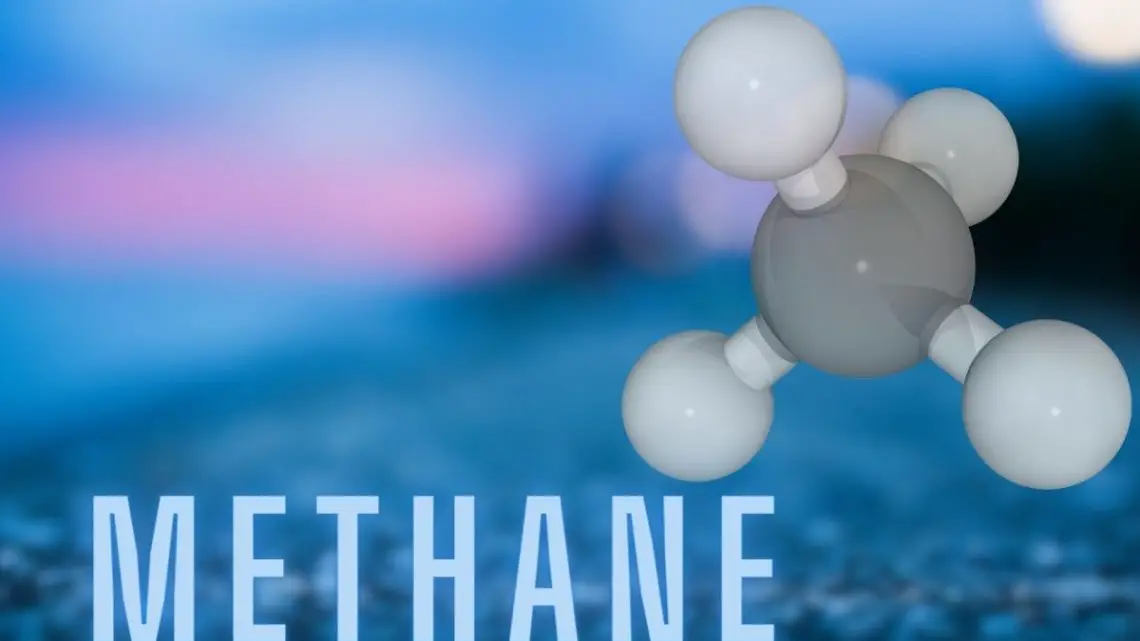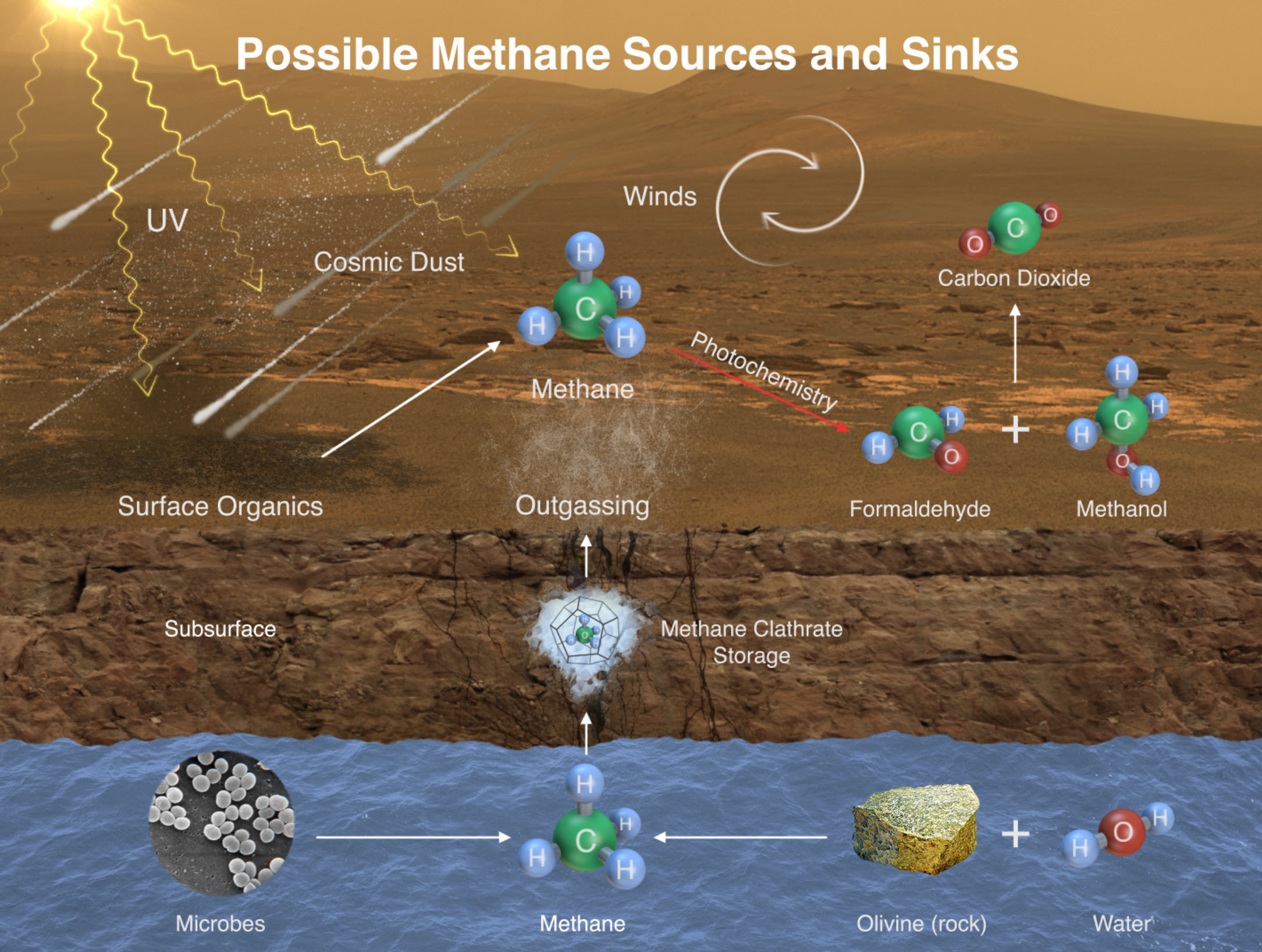
Methane Mirage: Understanding Subterranean Microbial Architects of Emission
August 25, 2023Methane, an influential yet elusive greenhouse gas, has long captivated scientific curiosity due to its impact on Earth’s climate system. The methane levels have constantly increased in the past years. According to data from the National Oceanic and Atmospheric Administration, the atmospheric methane levels were around 1,895.7 ppb in 2021.
Methane is composed of one atom of carbon and four atoms of hydrogen. Its chemical formula is CH4. Sources such as wetlands, livestock, and fossil fuel extraction are well-known contributors to atmospheric methane.
In this article, we will take a closer look at how microorganisms intricately choreograph the production and consumption of methane.
Exploring Methanogenic Microcosms
In the depths of oxygen-deprived environments, where life adapts to the absence of the life-sustaining gas, a remarkable class of microorganisms called methanogens thrives.
These microbial architects, often called the “first responders” to anaerobic habitats, hold the key to understanding the genesis of methane emissions. As we delve into methanogenic microcosms, a vivid tapestry of interactions, adaptations, and metabolic intricacies emerges.
Methanogens are pioneers of anaerobic environments, populating a range of habitats from marshes and wetlands to the digestive tracts of ruminant animals. Dairy and beef cattle release about 100 teragrams of methane every year.
They harbor an incredible species diversity within their ranks, each finely tuned to exploit specific niches and energy sources. Through a process known as methanogenesis, these microorganisms transform simple carbon compounds, such as carbon dioxide and acetate, into methane and carbon dioxide.
This intricate metabolic dance relies on a series of enzyme-driven reactions, where electrons are rapidly transferred, culminating in methane gas production. Industrial emissions are also one of the most significant factors in methane gas releases. This can lead to quick climate change. Hence, industrial plants must keep a check on their methane emissions.
While there can be different ways to do this, leveraging technology is the most efficient. A methane monitoring system can prove helpful in this scenario. With an advanced continuous methane emissions monitoring system, an operator can get constant updates on methane leaks.
It can also provide a gas plume image to help the operator understand where the leak is coming from. This can help him or her take the necessary precautionary steps to prevent methane emissions.
Implications for Climate and Beyond
The revelations stemming from the intricate world of subterranean microbial architects extend beyond scientific curiosity. They cast profound implications for understanding climate dynamics, environmental management, and the interconnectedness of Earth’s systems.
Climate Change Mitigation
The impact of subterranean microbial ecosystems on methane emissions presents a two-fold narrative for climate change mitigation.
On the one hand, the microbial dance of methanogens and methanotrophs in wetlands and sediments can significantly influence methane emissions. Understanding the intricate mechanisms that regulate these ecosystems can guide targeted interventions to manage and mitigate emissions at their source.
On the other hand, insights are gained from studying microbial contributions to methane emissions from geological formations, such as methane hydrates. These insights emphasize the need to consider these sources in global methane budgets and climate models.
Methane can affect the climate much more than other greenhouse gases. According to CI Sensing, a division of CI Systems, methane gas can have 80x more warming power when compared to carbon dioxide. The Environmental Defense Fund (EDF) has determined restricting methane emissions is one of the most expedient methods to combat global warming. This approach can yield swift and impactful results in mitigating climate change.
Ecosystem Management and Restoration
Knowledge of subterranean microbial ecosystems can guide ecosystem management and restoration efforts. Wetlands, for instance, are vital components of Earth’s carbon cycle and are influenced by methane-producing and methane-consuming microorganisms.
A nuanced understanding of these microbial communities can provide valuable insights for wetland conservation and restoration strategies. Ultimately, this knowledge contributes to the preservation of their crucial ecological services.
Energy and Bioremediation Applications
The unique metabolic capabilities of methanotrophs, capable of consuming methane as an energy source, hold potential beyond their role in regulating methane emissions. Recent data shows that methanotrophic bacteria can consume 30 million metric tons of methane annually.
Research into these microorganisms could pave the way for innovative applications, such as utilizing methanotrophs to convert methane from waste streams into biofuels. Furthermore, their ability to metabolize other hydrocarbons makes them attractive candidates for bioremediation efforts, helping to address pollution and restore contaminated sites.
Interdisciplinary Collaborations
The complexity of subterranean microbial ecosystems underscores the importance of interdisciplinary collaboration. Geologists, microbiologists, climatologists, and other experts must collaborate to unravel the intricate threads that connect microbial life, geological processes, and climate dynamics. These collaborations extend beyond science and into policy, fostering informed decision-making considering the full scope of methane emissions.

Image Source Credit Wikipedia
Microbial Architects of Balance: Methanotrophs
While methanogens are known for their role as methane producers in anaerobic environments, another group of microbial architects operates in a counterbalancing role: methanotrophs. These specialized microorganisms have developed an exceptional capacity to thrive on methane as their primary energy source.
Methanotrophs exist in diverse forms and are finely attuned to various ecological niches. They can be found in habitats as varied as wetlands, forest soils, and even the underbellies of Antarctic ice sheets.
Their presence extends beyond terrestrial environments, as aquatic methanotrophs thrive in the waters of lakes, rivers, and oceans. These microorganisms play a pivotal role in maintaining methane levels within these ecosystems through their regulatory function.
Methanotrophs possess unique enzymes known as methane monooxygenases, which allow them to convert methane into energy and biomass. This process is deeply intertwined with the global carbon cycle. Methanotrophs serve as a vital buffer against the excessive buildup of methane in the atmosphere. This role makes them a potential mitigator of climate change impacts.
Through methane consumption, these microorganisms assume a crucial role in mitigating the impact of this potent greenhouse gas. In doing so, they help maintain a fragile equilibrium between the production and consumption of methane.
However, the relationship between methanotrophs and methane emissions is more complex than a simple “clean-up” mechanism. Some methanotrophs thrive in the same environments where methane is produced, forming symbiotic partnerships that regulate local methane concentrations.
In wetland ecosystems, for instance, where methanogenesis is prevalent, methanotrophs engage in a delicate dance with methanogens, exerting a dynamic influence on methane emissions. This intricate interplay underscores the interconnectedness of microbial communities and their collective impact on Earth’s biogeochemical cycles.
Below the Surface: Methane’s Geological Odyssey
Data shows that 40% of methane emissions are due to natural processes, with wetlands contributing a considerable part. Hence, biological sources like wetlands and animals are widely recognized as methane contributors. However, a substantial portion of the gas originates from geological reservoirs that have remained concealed until recent years.
One of the most intriguing geological sources of methane is methane hydrate, also known as methane clathrate. This ice-like compound forms when methane molecules become trapped within water molecules in icy environments.
These hydrates exist beneath the seafloor in vast quantities, harboring a potential methane reservoir several times larger than all other fossil fuel deposits combined. The intricate interplay of temperature, pressure, and microbial activity plays a pivotal role in controlling the stability and release of methane hydrates. This phenomenon provides a valuable perspective on the geological mechanisms that impact methane emissions.
Conclusion
Delving into subterranean microbial communities reveals their significant role as architects of methane emissions. The interactions and processes these microorganisms orchestrate underscore their environmental influence.
It is clear that a comprehensive understanding of these subterranean players is essential. It can help devise effective strategies to mitigate methane’s impact on our climate.

FAQs about Methanotrophs: The Microbial Architects of Methane Balance
1. What are methanotrophs?
Methanotrophs are specialized microorganisms that use methane as their primary source of energy. They play a key role in regulating methane levels within various ecosystems.
2. Where can methanotrophs be found?
Methanotrophs are present in diverse habitats, including wetlands, forest soils, and beneath Antarctic ice sheets. They also exist in aquatic environments such as lakes, rivers, and oceans.
3. What unique ability do methanotrophs possess?
Methanotrophs possess unique enzymes known as methane monooxygenases. These enzymes allow them to convert methane into energy and biomass, effectively regulating the amount of methane in the environment.
4. How do methanotrophs contribute to the global carbon cycle?
Methanotrophs play a vital role in the global carbon cycle by consuming methane and converting it into energy and biomass. This process helps to prevent an excessive buildup of methane in the atmosphere.
5. How do methanotrophs impact climate change?
Through their ability to consume methane, methanotrophs help to mitigate the impact of this potent greenhouse gas on our climate. They serve as a natural buffer against excessive methane emissions.
6. Can methanotrophs and methanogens coexist?
Yes, methanotrophs and methanogens can coexist in the same environments. In fact, they often form symbiotic partnerships that regulate local methane concentrations. This is particularly evident in wetland ecosystems where both types of microorganisms are prevalent.
7. What are methane hydrates?
Methane hydrates, also known as methane clathrates, are ice-like compounds formed when methane molecules become trapped within water molecules in icy environments. These hydrates exist beneath the seafloor and harbor vast quantities of methane.
8. How does the stability and release of methane hydrates impact methane emissions?
The stability and release of methane hydrates are controlled by the intricate interplay of temperature, pressure, and microbial activity. Understanding these dynamics provides valuable insights into the geological mechanisms that impact methane emissions.



 With over 15 years of reporting hydrogen news, we are your premier source for the latest updates and insights in hydrogen and renewable energy.
With over 15 years of reporting hydrogen news, we are your premier source for the latest updates and insights in hydrogen and renewable energy.
Nowhere are we told how much methane will increase global temperature. If someone wants to claim that by 2100 methane will run-up global temperatures more than 0.05°C they should provide the source or show their work.